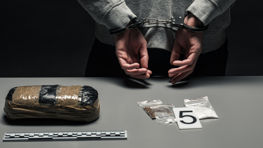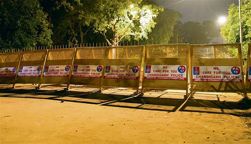
Festive dressing: Head adornment worn by women of Drok Pa tribe Photos by the writer
Ranjita Biswas
Ladakh — the land of high passes — is often called the ‘Cold Desert’ for the lack of vegetation as the region lies above the monsoon clouds, which feed India’s agricultural fields. The craggy mountains, the astonishing colours of granite edifices rising up to the blue sky, set Ladakh apart. The colours are also reflected in the beautiful jewellery that the women as well as men wear everyday. Some are less elaborate, the more intricate ones are adorned on festive days, but wearing some kind of jewellery is common in this region. In Ladakh, both men and women customarily wear jewellery though the jewellery worn by women is much more elaborate.
If you happen to be in Leh during the annual Ladakh festival in September, you would be able to catch a glimpse of these exquisite pieces of jewellery, mostly in bright stones and silver settings. Cultural troupes come from different parts of Ladakh and enchant everybody with their performance and finery.
Being near Tibet, Ladakh’s jewellery shows a remarkable similarity with those in the mountain-top region. Buddhism is another common thread and motifs in Buddhist iconography, like the lotus, symbol of enlightenment, recur in the pieces. In Buddhist philosophy, the flower is symbolic of rising above the mud (of human existence and suffering) to bloom and spread peace.
Ladakhi people believe in the power of stones. These are prized not only for their beauty but also for their significance. The stones which dominate the necklaces, bracelets, earrings and waist belts are turquoise and corals. Pearls, lapis lazuli, amber and quartz crystals are also used but these have less importance. Most of the precious stones are found in the Himalayas. These are usually set in high quality oxidised silver.
Turquoise is especially revered as a stone, considered even more precious than gold. The prayer beads also have turquoise predominantly as it symbolises wisdom and spiritual journeys. In the past, small pieces of turquoise were even used in barter transactions while the big ones were kept as family heirlooms, or gifted to lamas, or even to propitiate the demons. It is also believed that the stone can detect diseases.
Women performers at the Ladakh Festival display head pieces called perak, which are resplendent with bright turquoise stones stuck on a base of brown or black leather. It resembles a cobra, the ‘head’ starting from the forehead and coming down to the back of the head. The richness of a perak symbolises the woman’s status and family’s wealth.
Wearing a headdress in this high plateau region is quite common among the women. It could also be a way to keep away the intense cold.
In the Nubra valley where you can still see double-humped camels reminiscent of the old silk route when caravans plied, the head dress is called gonda. The coral is regarded as a ‘women’s stone’ and is often combined with turquoise in necklaces, bracelets, etc. The stone is believed to help women during their periods and control blood pressure. Often coral is combined with pearl too, the latter seen as a symbol of fertility. Corals, gemologists say, used to come here from Italy till the 18th century. Is that a Marco Polo connection, who had opened the Orient to the West? Who knows!
A bead from etched agate which is called dzi by the locals is highly prized and rarely seen or sold by owners for, they believe, it has mythical qualities and brings luck to the owner.
The beautiful, heavy necklaces with strings of beads usually carry a pendant called gau or ghau, which is actually an amulet box (charm) to protect the wearer from danger and harm.
The earrings are an elaborate affair. These are usually flat, done in silver, the long chains with jingles hanging from them delicately.
The bracelets, on the other hand, are not delicate but quite heavy made of silver and set with, usually, three large stones. Men, women and children, all wear bracelets though children’s bracelets are simpler. Finger-rings are also huge but here the metal rather than the stones are important.
Women also wear belts with buckles known as dodchas over their goncha dresses. Many contemporary jewellery designers have adopted these age-old beautiful designs in their work.


























